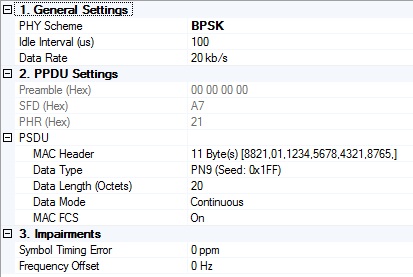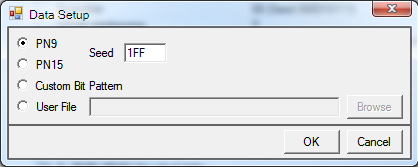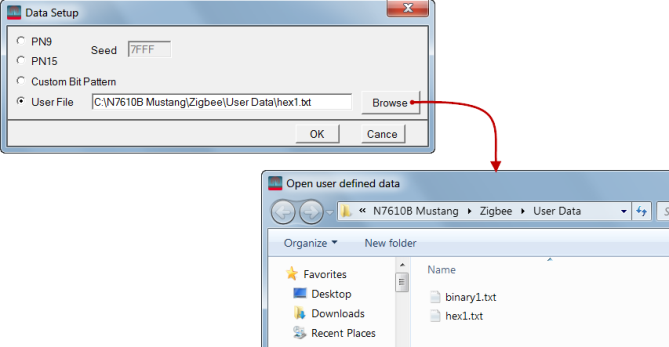
Click in the tree view to display the 802.15.4 setup. To learn about the frame structure and where these settings are applied within that structure, see the 802.15.4 concept topic.

Choices: O-QPSK | BPSK
Default: O-QPSK
Selects the 802.15.4 PHY scheme.
Range: 0–200000
Default: 100
Unit: us
Enter the idle interval in-between frames in seconds. The software accepts as many idle values as there are frames. When entering multiple idle values for a multi-frame setup, use a space or comma between values.
When idle interval is set to zero, a continuous waveform is generated. If there are more frames than values, the software restarts with the first value for the additional frames.
To determine how many frames are used in the signal, see the Number of Frames value in the Waveform Setup node.
Choices: 20 kb/s | 40 kb/s
Default: 20 kb/s
Selects the data rate for 802.15.4 BPSK PHY
Displays the Preamble field of PPDU in hexadecimal format.
Displays the SFD field of PPDU in hexadecimal format.
Displays the PHR field of PPDU in hexadecimal format. The value is automatically updated when the PSDU settings are changed.
These are the settings for the physical service data unit (PSDU) part of the frame that includes the payload data.
Click in the field, and then the dialog box icon  that appears to launch the MHR (MAC Header) - Hexadecimal Input dialog box. To use the dialog box, perform the following items as needed:
that appears to launch the MHR (MAC Header) - Hexadecimal Input dialog box. To use the dialog box, perform the following items as needed:
To enable the MAC header and to change values, click the MAC Header (hex) check box so that a check appears.
To disable the MAC Header,click the MAC Header (hex) so that the check box is unchecked.
For more information on the MAC header, refer to the IEEE standards 802.15.4.

For the MAC payload, click in the field, and then the dialog box icon  that appears to launch the Data Setup dialog box. In the dialog box, select the data type:
that appears to launch the Data Setup dialog box. In the dialog box, select the data type:
PN9
PN15
Custom Bit Pattern
User File
For the PN9 and PN15 selections, there is a field to set the seed. The Seed field is not applicable to the Custom Bit Pattern PN selections

When you select Custom Bit Pattern, the editor provides choices (see figure below) to enter data that includes loading a previously saved pattern. In addition, there is a 1 and 0 button for more resolution in adding bits. The keyboard 1 and 0 may also be used to enter values. Within the same software session, the software remembers the Custom Bit Pattern. So if another data type is selected and used, and then Custom Bit Pattern is reselected, the editor shows the previously entered custom pattern. This also applies to using Clear, exiting the pattern editor, and then reselecting Custom Bit Pattern.

There is also a User File selection. When selected, the Browse button becomes active. When clicked, the button launches the Open user defined data window that is used to navigate to and select the user data file. After selecting a file, the file path and name shows in the User File field.

The software accepts two forms of user data: binary and hex. The following figure shows an example of each data type. As shown in the figure, the hex data begins with an 'x' to indicate hex data. The 'x' can be either upper or lower case.

Range: 0–127
Default: 20
Enter the length of the MAC payload in octets. For a multi-frame signal, a value may be entered for each frame. Use a space or a comma between the values to show that a value is for the next frame. If there are more frames than values, the software restarts with the first value for the additional frames. The sum, of the entered value(s) plus the MAC FCS shows in Frame Length (Octets). The MAC FCS is added to each data length value.
To determine how many frames are used in the signal, see the Number of Frames value in the Waveform Setup node.
Choices: Continuous | Truncated
Default: Continuous
For a multi-frame signal, select the mode that is applied to the MAC payload. If there is only one frame in the signal, then there is no difference in the choices
|
Continuous |
payload data bits are continuously distributed across multiple frames | |
|
Truncated |
payload data bits are the same for all frames, with the data size truncated for one frame |
Choices: On | Off
Default: On
Enable or disable the MAC FCS.
|
|
On |
|
data bits fill the FCS part per the IEEE 802.15.4 standards and adds two Octets to the frame length These octets plus the Data Length (Octets) value determines the value shown in the Frame Length (Octets) field. When there are multiple Data Length (Octets) values, the FCS octets are added to each of them. |
|
|
Off |
|
used to simulate an invalid FCS case and does not add any octets to the frame length |
Range: –300 to 300 ppm
Default: 0
Enter an error rate value that is used to shift the symbol rate. This error is added to the standard sample clock in the waveform header.
Range: –200 to 200 kHz
Default: 0
Enters an offset to the nominal carrier frequency in Hertz.